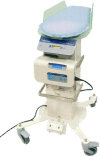Providing newborn resuscitation at the mother's bedside: assessing the safety, usability and acceptability of a mobile trolley
- PMID: 24885712
- PMCID: PMC4055396
- DOI: 10.1186/1471-2431-14-135
Providing newborn resuscitation at the mother's bedside: assessing the safety, usability and acceptability of a mobile trolley
Abstract
Background: Deferring cord clamping at very preterm births may be beneficial for babies. However, deferring cord clamping should not mean that newborn resuscitation is deferred. Providing initial care at birth at the mother's bedside would allow parents to be present during resuscitation, and would potentially allow initial care to be given with the cord intact. The aim of this study was to evaluate the usability of a new mobile trolley for providing newborn resuscitation by describing the range of resuscitation procedures performed on a group of babies, to assess the acceptability to clinicians compared with standard equipment, based on a questionnaire survey, to assess safety from post resuscitation temperature measurements and serious adverse event reports and to assess whether the trolley allowed resuscitation with the umbilical cord intact by assessing the proportion of babies that could be placed on the trolley to allow resuscitation with the cord intact.
Methods: The trolley was used when the attendance of a clinician trained in newborn life support was required at a birth. Clinicians were asked to complete a questionnaire about their experience of using the trolley. Serious adverse events were reported.
Results: 78 babies were managed on the trolley. Median (range) gestation was 34 weeks (24 to 41 weeks). Median (range) birth weight was 2470 grams (520 to 4080 grams). The full range of resuscitation procedures has been successfully provided, although only one baby required emergency umbilical venous catheterisation. 77/78 babies had a post resuscitation temperature above 36°C. There were no adverse events. Most clinicians rated the trolley as 'the same', 'better' or 'much better' than conventional resuscitation equipment. In most situations, the baby could be resuscitated with umbilical cord intact, although on 18 occasions the cord was too short to reach the trolley.
Conclusions: Immediate stabilisation at birth and resuscitation can be performed successfully and safely at the bedside using this trolley. In most cases this could be achieved with an intact umbilical cord.
Figures
References
-
- Kroll L, Twohey L, Daubeney PE, Lynch D, Ducker DA. Risk factors at delivery and the need for skilled resuscitation. Eur J Obstet Gynaecol Reprod Biol. 1994;44:175–177. - PubMed
-
- McDonald SJ, Middleton P. Effect of timing of umbilical cord clamping of term infants on maternal and neonatal outcomes. Cochrane Database Syst Rev. 2008;Issue 2 Art. No.: CD004074. doi:10.1002/14651858.CD004074.pub2. - PubMed
-
- Rabe H, Diaz-Rossello JL, Duley L, Doswell T. Effect of timing of umbilical cord clamping and other strategies to influence placental transfusion at preterm birth on maternal and infant outcomes. Cochrane Database Syst Rev. 2012;8 Art. No.: CD003248. doi:10.1002/14651858.CD003248.pub3. - PubMed
-
- RCOG. Prevention and management of postpartum haemorrhage. 2009. (Green Top Guidelines no 52). [ http://www.rcog.org.uk/files/rcog-corp/GT52PostpartumHaemorrhage0411.pdf]
Publication types
MeSH terms
Grants and funding
LinkOut - more resources
Full Text Sources
Other Literature Sources


